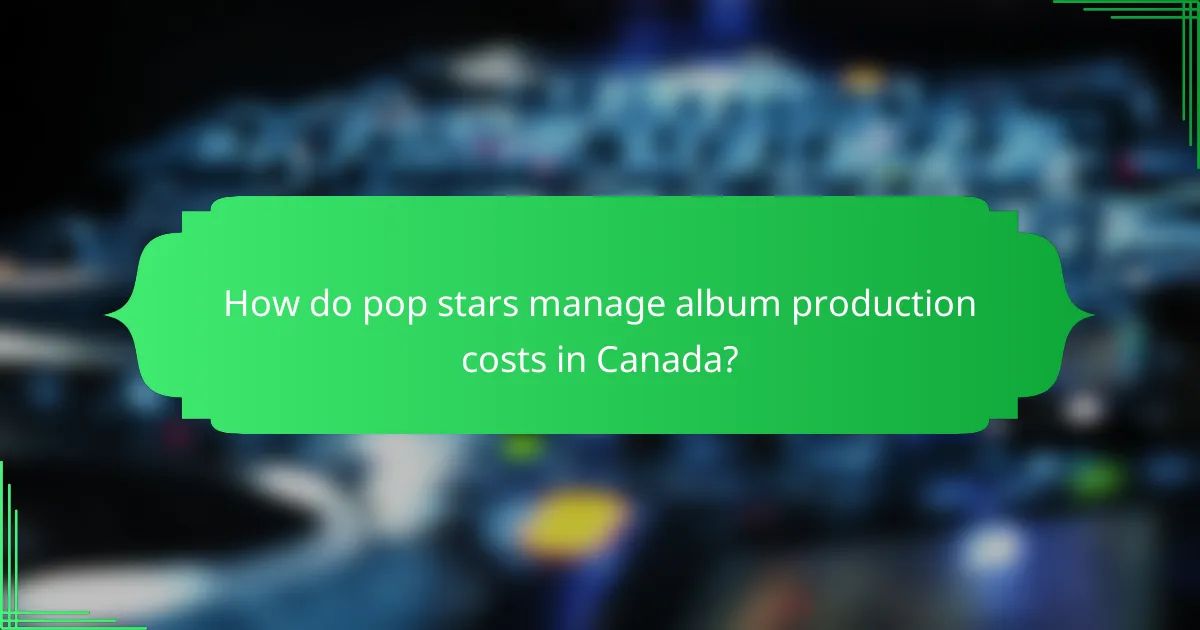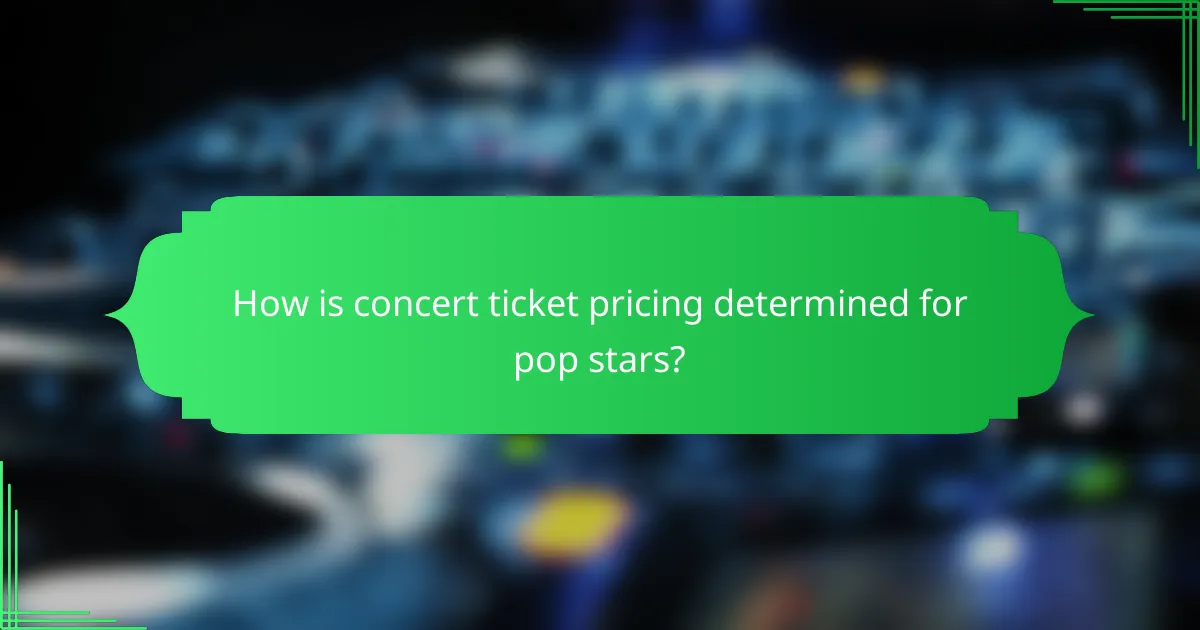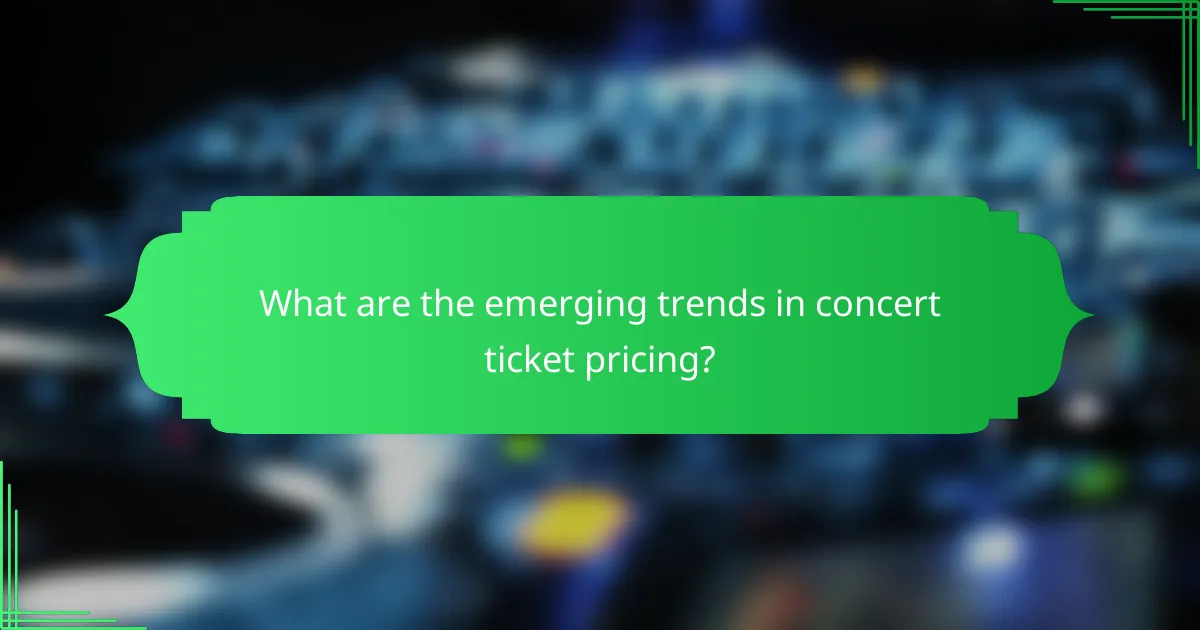Pop stars in Canada navigate the complexities of album production, promotional expenses, and concert ticket pricing to achieve success in a competitive industry. By strategically managing production costs and leveraging partnerships, artists can maintain high-quality standards while effectively promoting their work. Additionally, ticket pricing strategies are carefully crafted to balance revenue generation with fan accessibility, reflecting the artist’s popularity and demand.

How do pop stars manage album production costs in Canada?
Pop stars in Canada manage album production costs through careful budgeting, strategic partnerships, and leveraging local resources. By understanding the financial landscape and collaborating with experienced professionals, they can optimize expenses while maintaining high-quality production standards.
Average album production costs
In Canada, the average cost of producing an album can range from CAD 20,000 to CAD 100,000, depending on various factors such as the artist’s experience and the complexity of the project. Independent artists may spend on the lower end, while established pop stars often invest significantly more to ensure top-notch production quality.
Costs typically include studio time, session musicians, mixing, mastering, and marketing expenses. Artists should budget for unexpected costs, which can arise during the production process.
Key factors influencing production expenses
Several key factors influence album production expenses in Canada. The choice of studio and producer can greatly affect costs; high-profile studios and producers often command higher fees due to their reputation and expertise. Additionally, the length and complexity of the album, including the number of tracks and arrangements, also play a significant role in determining the overall budget.
Marketing and promotional strategies are crucial as well. Artists must allocate funds for promotional materials, music videos, and social media campaigns to ensure their album reaches the intended audience.
Top Canadian producers
Canada boasts several renowned producers who can help elevate an album’s quality. Notable figures include David Foster, known for his work with major pop artists, and Daniel Lanois, celebrated for his unique soundscapes. Collaborating with established producers can enhance an artist’s credibility and attract a wider audience.
Emerging producers also offer fresh perspectives and often work at lower rates, making them an attractive option for independent artists looking to manage costs effectively. Building relationships with local talent can lead to innovative collaborations and cost savings.

What are the promotional expenses for pop stars in Canada?
Promotional expenses for pop stars in Canada can vary widely, often ranging from tens of thousands to millions of Canadian dollars depending on the artist’s popularity and campaign scope. These costs typically cover marketing, advertising, public relations, and promotional events to boost album sales and concert attendance.
Typical marketing budgets
Marketing budgets for pop stars in Canada generally fall between CAD 50,000 and CAD 500,000 for a single album release. High-profile artists may spend significantly more, sometimes exceeding CAD 1 million, particularly if they are launching a major tour or album. Budgets are allocated to various channels, including social media, radio, and television advertising.
Smaller or emerging artists may operate on tighter budgets, often relying on grassroots marketing strategies and social media to reach their audience without incurring high costs.
Effective promotional strategies
Effective promotional strategies for pop stars in Canada include leveraging social media platforms, engaging with fans through live streams, and collaborating with influencers. Utilizing targeted advertising on platforms like Instagram and Facebook can help reach specific demographics, increasing visibility and engagement.
Additionally, hosting listening parties, participating in interviews, and creating visually appealing music videos can enhance an artist’s profile and generate buzz around their releases.
Case studies of successful campaigns
A notable example is The Weeknd’s promotional strategy for his album “After Hours,” which included a mix of social media teasers, a high-profile Super Bowl performance, and collaborations with popular brands. This multi-faceted approach helped him achieve significant album sales and streaming numbers.
Another successful campaign was by Shawn Mendes, who utilized a combination of fan engagement through social media and a well-timed tour announcement to boost interest in his album. His strategy demonstrated the effectiveness of direct fan interaction in driving promotional success.

How is concert ticket pricing determined for pop stars?
Concert ticket pricing for pop stars is influenced by various factors including demand, venue size, and artist popularity. These elements combine to create a pricing strategy that maximizes revenue while ensuring accessibility for fans.
Factors affecting ticket prices
Several key factors determine ticket prices for pop stars. Demand plays a crucial role; higher demand typically leads to increased prices. Additionally, the venue’s capacity and location can significantly impact pricing, with larger venues often offering lower per-ticket prices due to economies of scale.
Other considerations include the artist’s popularity, the type of event (e.g., festival vs. solo concert), and production costs. For instance, a high-profile artist may command premium prices due to their established fan base and brand value.
Average ticket prices for major Canadian pop stars
In Canada, average ticket prices for major pop stars can vary widely. Generally, prices range from CAD 50 to CAD 200 for standard concerts, depending on the artist and venue. For instance, tickets for well-known artists may start at a higher price point, while emerging stars might offer more affordable options.
Special events or festivals featuring multiple artists can also affect pricing, with some tickets reaching CAD 300 or more for premium experiences. It’s essential for fans to compare prices across platforms to find the best deals.
Dynamic pricing models
Dynamic pricing models are increasingly used in the concert industry, allowing prices to fluctuate based on real-time demand. This means that ticket prices can rise as the event date approaches or as tickets sell out, maximizing revenue for the artist and promoters.
While dynamic pricing can lead to higher costs for last-minute buyers, it also offers opportunities for fans to purchase tickets at lower prices during initial sales. Understanding this model can help fans make informed purchasing decisions, potentially saving money if they buy early.

What are the trends in album production for pop stars?
Recent trends in album production for pop stars emphasize collaboration, digital innovation, and a focus on high-quality sound. Artists are increasingly working with diverse producers and utilizing advanced technology to enhance their music while managing costs effectively.
Shifts in production techniques
Album production techniques have evolved significantly, moving from traditional studio recordings to more flexible, remote collaborations. Many pop stars now record tracks in home studios or use digital audio workstations (DAWs) to produce music, allowing for greater experimentation and creativity.
Additionally, the trend of using live instrumentation alongside digital sounds is gaining popularity. This hybrid approach can create a richer sound and appeal to a broader audience, as artists blend genres and styles.
Impact of technology on music production
Technology has transformed music production, making it more accessible and efficient. Software tools like Pro Tools, Ableton Live, and Logic Pro enable artists to produce high-quality music without the need for expensive studio time. This democratization allows emerging pop stars to enter the industry with lower upfront costs.
Moreover, advancements in artificial intelligence and machine learning are beginning to influence music creation. AI can assist in generating melodies, harmonies, and even lyrics, providing artists with new creative possibilities while streamlining the production process.

How do promotional expenses vary by region in Canada?
Promotional expenses for pop stars can significantly differ across Canada, influenced by factors such as market size, audience demographics, and local media costs. Regions like Ontario and British Columbia typically see higher promotional budgets due to larger populations and more competitive music markets compared to provinces with smaller populations.
Regional marketing differences
In Canada, promotional expenses can vary widely by region. For instance, major urban centers like Toronto and Vancouver often allocate larger budgets for advertising and promotional events, sometimes reaching into the hundreds of thousands of Canadian dollars. In contrast, smaller provinces may spend considerably less, often relying on grassroots marketing strategies.
Additionally, the choice of media channels can differ. Urban areas may focus on digital marketing and high-profile events, while rural regions might utilize local radio and community events to engage audiences.
Audience engagement strategies
Effective audience engagement strategies also vary by region. In larger cities, pop stars often leverage social media campaigns and influencer partnerships to reach fans quickly. This can involve spending on targeted ads that can range from a few hundred to several thousand dollars, depending on the campaign’s scale.
In contrast, in smaller markets, artists might engage with fans through local meet-and-greet events or intimate performances, which can be more cost-effective and foster a stronger community connection. Understanding these regional differences is crucial for optimizing promotional budgets and maximizing audience reach.

What are the emerging trends in concert ticket pricing?
Emerging trends in concert ticket pricing include dynamic pricing models, increased reliance on resale markets, and the integration of advanced ticketing technologies. These trends reflect a shift towards more flexible pricing strategies that respond to demand and market conditions.
Influence of resale markets
Resale markets have significantly impacted concert ticket pricing by allowing fans to buy and sell tickets at varying prices. This can lead to inflated prices for popular events, with some tickets selling for several times their original face value. Artists and promoters are increasingly monitoring these markets to adjust their pricing strategies accordingly.
For example, platforms like StubHub and Viagogo enable fans to resell tickets, which can create a secondary market that influences primary ticket prices. It’s essential for consumers to be aware of these dynamics, as they may find better deals or face higher costs depending on demand.
Innovations in ticketing technology
Innovations in ticketing technology are reshaping how tickets are sold and priced. Mobile ticketing, blockchain technology, and AI-driven pricing algorithms are becoming more common, enhancing security and efficiency. These technologies can help prevent fraud and ensure that tickets reach genuine fans rather than scalpers.
For instance, mobile apps allow for easy ticket transfers and real-time pricing adjustments based on demand. Fans should familiarize themselves with these technologies to make informed purchasing decisions and take advantage of potential savings.

What is the future of pop star album production?
The future of pop star album production is increasingly influenced by technology and changing consumer preferences. Artists are leveraging digital tools for collaboration and distribution, while also adapting to the demand for more frequent releases and diverse formats.
Trends in Album Production
Album production is shifting towards a more collaborative and flexible approach. Many pop stars are now using online platforms to work with producers and songwriters from around the world, allowing for a diverse range of sounds and styles. Additionally, the rise of home studios has made it easier for artists to record and produce music without the need for expensive studio time.
Another trend is the focus on shorter albums or EPs, catering to listeners’ preferences for bite-sized content. This shift allows artists to release music more frequently, keeping their audience engaged and relevant in a fast-paced industry.
Impact of Streaming Services
Streaming services have fundamentally changed how albums are produced and consumed. Artists now prioritize singles and playlists over traditional album formats, as these often generate more streams and revenue. This shift can lead to a more fragmented listening experience, where fans may not engage with an entire album.
Moreover, streaming platforms provide valuable data on listener preferences, enabling artists to tailor their productions to what resonates most with their audience. This data-driven approach can enhance the overall success of an album.
Cost Considerations
The costs associated with album production can vary widely based on the artist’s approach and resources. Traditional studio recording can range from thousands to hundreds of thousands of dollars, depending on the complexity and duration of the project. However, with advancements in technology, many artists are finding ways to produce high-quality music at a fraction of the cost.
Budgeting for promotional expenses is also crucial. Artists should allocate funds for marketing, music videos, and social media campaigns to maximize the impact of their album release. A well-planned promotional strategy can significantly enhance an album’s reach and profitability.
Future Challenges
As the music industry evolves, pop stars face several challenges in album production. The oversaturation of content can make it difficult for new releases to stand out, requiring artists to be more innovative in their marketing strategies. Additionally, the reliance on digital platforms means that artists must continually adapt to changes in algorithms and consumer behavior.
Another challenge is the need for artists to maintain authenticity while navigating commercial pressures. Balancing creative expression with market demands is essential for long-term success in the industry.
